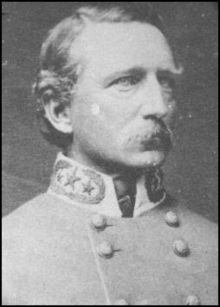Joseph B. Kershaw
| Joseph Brevard Kershaw | |
|---|---|
 |
|
| Born |
January 5, 1822 Camden, South Carolina |
| Died | April 13, 1894 (aged 72) Camden, South Carolina |
| Buried at | Quaker Cemetery Camden, South Carolina |
| Allegiance |
|
| Service/branch |
|
| Years of service | 1861–65 (CSA) |
| Rank |
|
| Battles/wars | |
Joseph Brevard Kershaw (January 5, 1822 – April 13, 1894) was a lawyer, judge, and a Confederate general in the American Civil War.
Kershaw was born at Camden, South Carolina, admitted to the bar in 1843, and was a member of the South Carolina Senate from 1852 to 1856. Kershaw saw battle during the Mexican-American War, but fell dangerously sick and was permitted to return home.
At the start of the Civil War Kershaw commanded the 2nd South Carolina Volunteer Infantry regiment and took part in the First Battle of Bull Run. The 2nd South Carolina was present at Morris Island during the Fort Sumter incident. He was commissioned brigadier general on February 13, 1862, and commanded a brigade in Robert E. Lee's Army of Northern Virginia during the Peninsula Campaign, at the close of which he continued with Lee and took part in the Northern Virginia Campaign and Maryland Campaign. Towards the end of the Battle of Fredericksburg, he succeeded Brig. Gen. T. R. R. Cobb, upon the latter's death, and repulsed the last two attacks made by the Federals on Marye's Heights.
The next year he was engaged in the Battle of Gettysburg and then was transferred with Lt. Gen. James Longstreet's corps to the West, where he took part in the charge that destroyed the Federal right wing at Chickamauga. After the relief of McLaws following the battle of Knoxville Kershaw was given the command of the division. When Longstreet returned to Virginia, he commanded a division in the battles of the Wilderness, Spotsylvania Court House, and Cold Harbor, and was engaged in the Shenandoah campaign of 1864 against Maj. Gen. Philip Sheridan. After the evacuation of Richmond, his troops formed part of Lt. Gen. Richard S. Ewell's corps, which was captured at the Battle of Sayler's Creek, April 6, 1865.
...
Wikipedia
